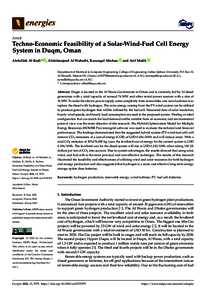Document
Techno-economic feasibility of a solar-wind-fuel cell energy system in Duqm, Oman.
Identifier
DOI: 10.3390/en15155379
Source
Energies. v. 15, 15, 5379
Contributors
Country
Switzerland
Publisher
MDPI.
Gregorian
2022-08-01
Language
English
English abstract
Duqm is located in the Al Wasta Governorate in Oman and is currently fed by 10 diesel generators with a total capacity of around 76 MW and other rental power sources with a size of 18 MW. To make the electric power supply come completely from renewables, one novel solution is to replace the diesel with hydrogen. The extra energy coming from the PV-wind system can be utilized to produce green hydrogen that will be utilized by the fuel cell. Measured data of solar insolation, hourly wind speeds, and hourly load consumption are used in the proposed system. Finding an ideal configuration that can match the load demand and be suitable from an economic and environmental point of view was the main objective of this research. The Hybrid Optimization Model for Multiple Energy Resources (HOMER Pro) microgrid software was used to evaluate the technical and financial performance. The findings demonstrated that the suggested hybrid system (PV-wind-fuel cell) will remove CO2 emissions at a cost of energy (COE) of USD 0.436/kWh and will reduce noise. With a total CO2 emission of 205,676,830 kg/year, the levelized cost of energy for the current system is USD 0.196/kWh. The levelized cost for the diesel system will rise to USD 0.243/kWh when taking 100 US dollars per ton of CO2 into account. Due to system advantages, the results showed that using solar, wind, and fuel cells is the most practical and cost-effective technique. The results of this research illustrated the feasibility and effectiveness of utilizing wind and solar resources for both hydrogen and energy production and also suggested that hydrogen is a more cost-effective long-term energy storage option than batteries.
ISSN
1996-1073
Resource URL
Category
Journal articles

